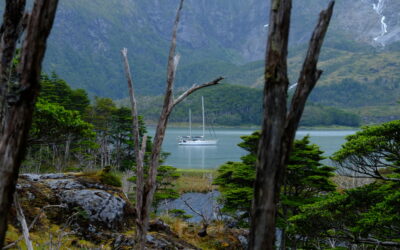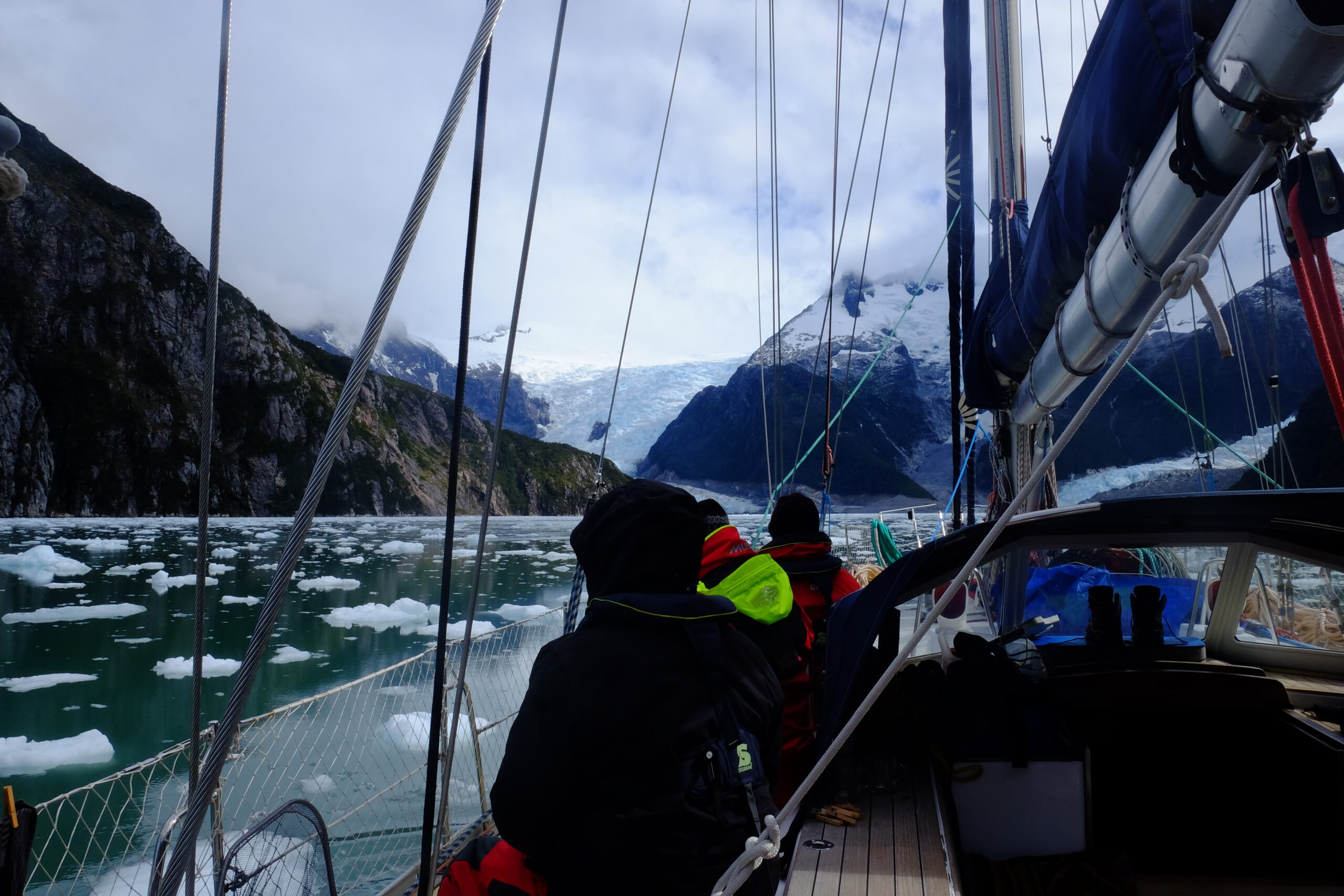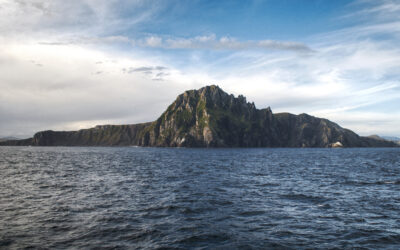[Heading South #13] From Buenos Aires (Argentina) to Puerto Williams (Chile) – Final Part

Association Karukinka
Loi 1901 - d'intérêt général
Derniers articles
Suivez nous
Logbook of our sailing journey in Argentine Tierra del Fuego, from Rio Grande to Ushuaia, via the Le Maire Strait, which separates the Mitre Peninsula and Isla de los Estados. #sailing in tierra del fuego
A new morning dawns with magnificent sunshine! We leave Caleta Misión and, with all sails set, bid farewell to the largest city in the Argentine province of Tierra del Fuego: Rio Grande.
![[Cap au Sud #13] de Buenos Aires (Argentine) à Puerto Williams (Chili) - Dernière partie 1 sy milagro sailing in patagonia sailboat tierra del fuego argentina](https://karukinka.eu/wp-content/uploads/2025/07/474137765_1141499590722842_6801742642504635288_n.jpg)
We sail close-hauled at 5 knots, with a pleasant 10–12 knot breeze allowing us to enjoy the landscape of the deserted shores of the main island of Tierra del Fuego. In the afternoon, we reunite with some faithful friends who have accompanied us since we left Buenos Aires: about fifteen Commerson’s dolphins! They escort us once again for over an hour, while a few petrels and albatrosses take advantage of the gusts to soar around us. All this commotion wakes up a sea lion sleeping on its back, wrapped in kelp, who opens its big eyes in surprise as we approach! Yet another exceptionally calm day of sailing at 54 degrees South, followed by a peaceful night.
The conditions remain perfect for the region: under an overcast sky and a beam wind of 12–15 knots, Milagro speeds along, with a little help from the current, averaging over 8 knots. It’s very steady and comfortable. For once, you could almost leave things lying around on board and find them in the same place an hour later! Around 4 a.m., a few raindrops fall—the first since Bahia San Blas.
At 6:15 a.m., my watch is over, but before heading to my bunk, I linger to enjoy the calm. Lauriane is making coffee while I gaze toward the stern. Suddenly, a black fin rises straight out of the water, higher and higher… it’s huge, maybe 1.2 meters tall, heralding the arrival of a large male killer whale, who lets out a powerful breath in the calm dawn. He is accompanied by his smaller female, recognizable by her much smaller, sickle-shaped fin, like a dolphin’s. As soon as we spot them, they vanish into the mysterious depths of the ocean… the power and joy of fleeting encounters.
At the same time, we reach Cape San Diego, the easternmost tip of Argentine Tierra del Fuego. This part of the main island, known as the Mitre Peninsula, has recently become a protected nature reserve. It features vast peat bogs, numerous rivers, and mountains that have never been explored. It’s somewhat the “forgotten” region of Tierra del Fuego, a true carbon sink and a sanctuary for Fuegian flora and fauna. Here, we encounter large groups of albatrosses, many of them young and still clumsy with their large wings as they try to take off.
At 9 a.m., we gybe to enter the legendary Le Maire Strait. The conditions change, and many animals (southern dolphins, sea lions, petrels, and black-browed albatrosses) take turns accompanying us. The strong tidal current is visible on the surface, sometimes reminding Damien and Lauriane of the Corryvreckan whirlpool they experienced in Scotland a few months ago. Crossing this strait is not to be taken lightly: depending on the combination of wind and tide, it can be a real jackpot—standing waves can exceed 8 meters, forming insurmountable walls if you get caught in the turmoil. A quick glance at a shipwreck chart is enough to draw a parallel between these waters and those of the famous Cape Horn, just a few dozen nautical miles further south.
![[Cap au Sud #13] de Buenos Aires (Argentine) à Puerto Williams (Chili) - Dernière partie 2 sailing in tierra del fuego patagonia mitre peninsula isla de los estados sailing patagonia](https://karukinka.eu/wp-content/uploads/2025/07/IMG-20250707-WA0003-1-1024x760.jpg)
![[Heading South #13] From Buenos Aires (Argentina) to Puerto Williams (Chile) – Final Part 1 Séjour voilier écosse, Séjour voilier Norvège, Croisière voilier Ecosse, Croisière voilier Norvège, Cap Nord à la voile, Sailing Norway, Sailing Scotland, Blue Water sailing, Stage voile hauturier, stage de voile côtier, sailing hébrides, voilier hébrides, navegar escocia, navegar noruega, navegar por los fiordos, velero escocia, velero noruega, navegar en finnmark, navegar en escocia, navegar en las hebridas, navegar costa oeste escocia, velero islas escocia, navegar islas escocia, sailing scottish islands, naviguer iles écossaises, IMG 20250707 WA0007](https://karukinka.eu/wp-content/uploads/2025/07/IMG-20250707-WA0007-980x735.jpg)
On our port side, we spot the rugged silhouette of Isla de los Estados, home to the “Lighthouse at the End of the World” for Jules Verne fans, “the Island of Abundance” (“Chuanisin”) for the Yagán people who used to fish there in their bark canoes, and “the Cordillera of Infinity” invoked by Selk’nam shamans during their rituals. Seeing the mountains of Isla de los Estados from Cape San Diego in bad weather must be an ineffable sight.
![[Cap au Sud #13] de Buenos Aires (Argentine) à Puerto Williams (Chili) - Dernière partie 4 le maire strait mitre peninsula sailing patagonia ushuaia sailboat patagonia argentina](https://karukinka.eu/wp-content/uploads/2025/07/IMG-20250707-WA0006-1024x768.jpg)
The Mitre Peninsula’s coastline is shrouded in low clouds and wisps of mist, giving the whole scene an atmosphere worthy of the best Jurassic Park photo sequences! We continue gybing, interrupted by one of Aude’s secret lunches. Everyone is on deck not to miss a single moment of this crossing of the strait and rounding of Tierra del Fuego’s tip. About ten fur seals swim and dive behind us when an extraordinary “floating barrier” appears ahead: hundreds of albatrosses are sitting on the water for some unknown reason, right in front of our bow! They barely move to let us pass, and we take care not to disturb them.
By early afternoon, we are only 100 nautical miles from Ushuaia! Just before anchoring for the night in Aguirre Bay, we spot the blows of our first four southern right whales! We heave to, to better appreciate their proximity, the sound of their powerful breaths, and try to listen to their underwater conversations with the hydrophone. In the late afternoon, we reach Puerto Español and drop anchor to enjoy a real night’s sleep before continuing westward.
Wake-up at 6 a.m., departure at 7 under a low, gray sky and a light, cold drizzle: the “drought” between Buenos Aires and Rio Grande is over—welcome to the humid subpolar climate of the Patagonian channels! As the morning goes on, the sky clears, and sunny spells break through while showers fall here and there in the distance. Like in Iceland, you get all four seasons in a day here! In fact, from subpolar in the morning, the atmosphere turns spring-like by the afternoon.
![[Cap au Sud #13] de Buenos Aires (Argentine) à Puerto Williams (Chili) - Dernière partie 5 sailboat in tierra del fuego sailing patagonia by sailboat beagle channel patagonian channels adventure crew in patagonia](https://karukinka.eu/wp-content/uploads/2025/07/IMG-20250707-WA0011-e1751887928651-783x1024.jpg)
We approach the first islands marking the entrance to the Beagle Channel: Nueva, Picton, and Lennox, and it’s a profusion of colors: the whiteness of the first snow patches, shades of green from the dense, wind-twisted forest, and the palette of grays and ochres from the bare rocks. A wealth of wildlife continues to accompany us: Magellanic penguins, fur seals, albatrosses, cormorants, and our first Arctic terns. And the powerful blows of several right whales basking at the foot of the channel’s cliffs.
![[Cap au Sud #13] de Buenos Aires (Argentine) à Puerto Williams (Chili) - Dernière partie 6 hydrophone rorquals whale listening whale wtaching in tierra del fuego beagle channel patagonia sailboat adventure patagonia](https://karukinka.eu/wp-content/uploads/2025/07/IMG-20250707-WA0010-769x1024.jpg)
By midday, the Beagle Channel turns into a lake, and there isn’t a breath of wind! We are forced to motor ahead, waiting for the wind to return. Late in the afternoon, another emotional moment: we arrive opposite Puerto Williams, the southernmost town in the world (3,500 inhabitants), located on Chile’s Navarino Island, dominated by the jagged peaks of the Dientes de Navarino. At sunset, José, a close and longtime friend of Lauriane, waves to us from the shore. We spot him in the distance, accompanied by his friend Miguel and his little dog Fea-Fea, and wave back. José is not just anyone: he is the former president of the Yagán community of Navarino Island, a fisherman and craftsman, and above all, a living encyclopedia of his culture and regional cartography. José greets our arrival from the beach (Puerto Williams, Navarino Island, Patagonian channels, Chile).
José comes to greet our arrival from the beach (Puerto Williams, Navarino Island, Patagonian channels, Chile)
![[Cap au Sud #13] de Buenos Aires (Argentine) à Puerto Williams (Chili) - Dernière partie 7 sailing expedition patagonia sailboat ushuaia tierra del fuego patagonian channels by sailboat sailing in tierra del fuego puerto williams](https://karukinka.eu/wp-content/uploads/2025/07/IMG-20250707-WA0013-1024x768.jpg)
Arriving here after such a long journey is huge for us: our families and friends followed us thanks to the tracker. But realizing how much we were awaited here by locals gives a whole new and powerful dimension that we have only really begun to understand since Rio Grande.
Not wanting to arrive at our destination at night and to enjoy the last moments of calm before returning to the city, we anchor 10 nautical miles from Ushuaia at 1 a.m.
![[Cap au Sud #13] de Buenos Aires (Argentine) à Puerto Williams (Chili) - Dernière partie 8 voilier en terre de feu rio grande peninsule mitre patagonie en voilier argentine](https://karukinka.eu/wp-content/uploads/2025/07/Rio-Grande_Ushuaia_Tierra-del-Fuego-Patagonie-768x1024.jpg)
Friday, January 24, 2025
24th and final morning of this offshore voyage along the Argentine coast: we have reached the very end of Argentine Patagonia, in Ushuaia! The crew wakes me up because, after days of jokingly poking my head out of the companionway to ask if we had finally arrived in Ushuaia, this time it’s true—we’re here! The town and the surrounding landscape look just as I remembered them from 2013. It’s the end of a journey of over 2,000 nautical miles, 24 days with a few stopovers to avoid bad weather or allow crew members to return to work on time, from dry heat to damp cold, and finally a crossing of the Roaring Forties and Furious Fifties in very favorable conditions!
![[Cap au Sud #13] de Buenos Aires (Argentine) à Puerto Williams (Chili) - Dernière partie 9 sailing to Patagonia blue ocean adventure patagonia sailing patagonia sailboat](https://karukinka.eu/wp-content/uploads/2025/07/IMG-20250707-WA0014-1024x768.jpg)
We’re now moored at the Afasyn club pontoon, facing the city. It’s all a bit mythical, since this is where sailboats set off for the channels and the Antarctic Peninsula. If you’d told me one day I’d be on a sailboat docked at this pontoon… I wouldn’t have believed it!
![[Cap au Sud #13] de Buenos Aires (Argentine) à Puerto Williams (Chili) - Dernière partie 10 sailing in tierra del fuego by sailboat afasyn sailing in ushuaia patagonia](https://karukinka.eu/wp-content/uploads/2025/07/IMG-20250707-WA0015-1024x768.jpg)
We quickly tidy up Milagro so we can stretch our legs in town and take care of the necessary formalities (naval prefecture and customs). In the evening, we celebrate our arrival with some well-deserved “land food.”
Departing from Saint Nazaire, Milagro and her crew have arrived—and this arrival also feels like a new beginning: heading for the channels of the Cape Horn Biosphere Reserve, where there is so much to study and explore.
![[Cap au Sud #13] de Buenos Aires (Argentine) à Puerto Williams (Chili) - Dernière partie 11 sailboat crew sailing to ushuaia patagonian channels blue ocean adventure](https://karukinka.eu/wp-content/uploads/2025/07/IMG-20250707-WA0019-1024x768.jpg)
To read the other chapters of our logbook from Saint Nazaire, visit our blog!
And to join our association and sail with us, click here: https://karukinka.eu/fr/contact/devenir-membre/
Details of the sailing courses are available in the club section of the site or on the dedicated site: https://karukinka-exploration.com/
Views: 30


![[#8 – Ireland–Scotland 2024] from Loch Buie to the sacred Isle of Iona](https://karukinka-exploration.com/wp-content/uploads/2024/07/Iona_LL-400x250.jpg)



